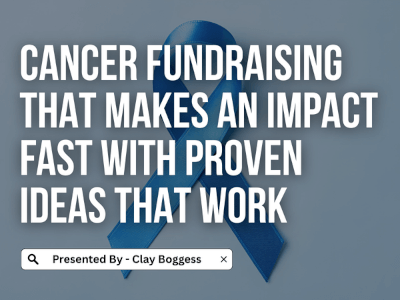
Effective Donor Communication and Appreciation.
Whether you have a pool of active donors or are in the process of identifying and landing donors from your network, donor communications and appreciation are crucial to your success. These tactics must be constant and ongoing, not only during an active campaign. These methods require resources, including capital and labor, but the results are worth the effort.
Let’s discuss why communication and appreciation are important and how to manage the processes best.
Why Communication and Appreciation Are Critical
Frequent donor communication and expressing adequate appreciation can drive your fundraising results. These methods foster relationships with current and potential donors while showing that their funding is useful and valued.
As explained by the Giving Institute, the outcome of maintaining these practices is moving away from asking for and receiving money with fleeting results to transformational fundraising: an intentional growth toward a long-term relationship.
These practices are based on more than theory. A survey by Dr. Adrian Sargeant defining why donors stop giving proved that only about half of donors could not afford to give. What went wrong? Many forgot about the organization entirely, believing it didn’t need their funds.
13% of donors claimed they stopped giving because the organization did not thank them for their past donations, and 19% of donors stopped giving due to a lack of communication. These simple practices can help you avoid losing funding opportunities.
Donor Communication
Donor communication refers to any interaction with your donors outside of asking for and receiving funding. This builds a relationship and keeps the donor in the loop.
Methods of Communication
Examples of methods of donor communication include:
- Newsletter: Send a monthly newsletter with brief updates. This may look like a summary of a successful school theater event or an update on the positive impact a past campaign had on your school.
- Email Updates: Send stories and progress reports via personalized emails. These can be slightly more thorough than the newsletters and directly relate to campaigns that the specific donor has participated in.
- Social Media and Networking Sites: Connect with your donors on social media and networking sites. Be present and active, for instance, congratulating a donor on a career move posted on a networking site.
Bonus Tip: These methods aren’t only valuable with your current donors. You can use these communication tactics to keep in touch with your network of potential donors as well. Building and strengthening relationships may turn a potential donor into an active donor.
Donor Appreciation
Your donors offer a lot of valuable support to your school. Give them recognition for this. This offers a positive experience for the donor, making it more likely they will give again.
Methods of Expressing Appreciation
Methods of expressing donor appreciation include:
- Automated Donation Response: Schedule an automatic thank you email, text, or pop-up thanking the donor for their assistance.
- Thank You Letters: Mail thank you letters. Include how you put the funds to use and a message of appreciation.
- Gift Baskets: Send a gift basket. Popular options include snacks, candy, or school spirit gear such as staplers or tumblers with your school’s name or mascot.
- Donor Events: Host a donor event. This can be anything from a luncheon to a day-long outing.
- School Event Invites: Directly invite donors to attend school events such as big football games or band and choir concerts.
Bonus Tip: Measure your appreciation efforts to the amount of giving to ensure you are not hurting your cause by spending too many resources on donor appreciation. A small campaign may not warrant a donor event, whereas a notable campaign with an extremely high profit margin may. You can send a thank you letter to a donor who gives once versus a gift basket or school gear to a donor who gives quarterly.
Automating the Process
Donor communications and appreciation can become daunting as your network grows larger. Automating the process can relieve your workload while ensuring every donor gets noticed and no step is forgotten. Several programs you can download allow you to customize and automate your communications.
A few examples of what this might look like for your school include:
- Mailer Systems: Use mailer systems to create templates and schedule email communications. Many systems allow you to track and analyze recipients’ responses.
- CRM Systems: CRM (customer relationship management) technology organizes and manages all aspects of communications. Store network data, automate communication flows, and track and analyze success rates in one place.
- Digital Calendars: For a simpler automation process, use a digital calendar to set communication reminders. You may even share your calendar with your donor network, allowing them to schedule meeting times with you.
- Task Management Tools: Task management tools schedule, delegate, and track tasks. You can use these systems to oversee aspects of communication and tasks related to showing donor appreciation.
Author Bio
Clay Boggess has been designing fundraising programs for schools and various nonprofit organizations throughout the US since 1999. He’s helped administrators, teachers, and outside support entities such as PTAs and PTOs raise millions of dollars. Clay is an owner and partner at Big Fundraising Ideas.



